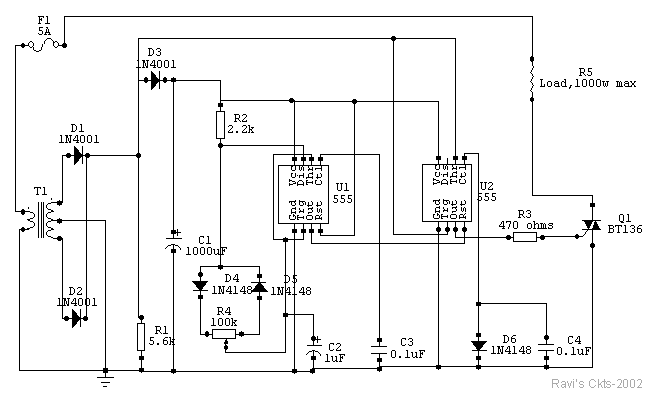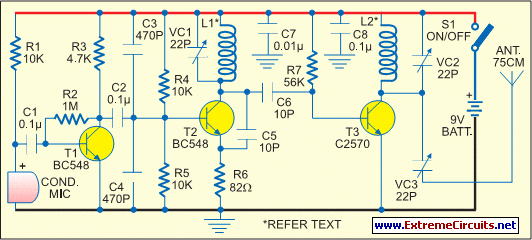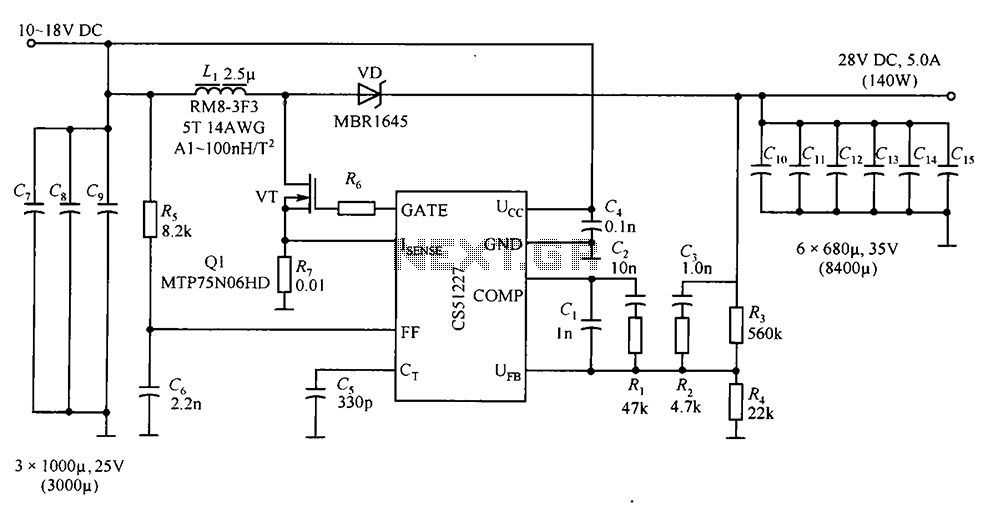
Solid State Power Controller

The circuit is built around two 555 timer ICs, U1 and U2. U1 is configured as a variable duty cycle oscillator with a constant time period of approximately 0.1 seconds. The duty cycle can be adjusted from 0 to 100 percent using the R4 potentiometer. The output of U1 (pin 3) is connected to the reset input (pin 4) of U2. U2 is configured as a comparator with hysteresis, functioning as a Schmitt trigger. Diode D6 sets the control voltage (pin 5) terminal at 0.7V. The threshold (pin 6) and trigger (pin 2) terminals are connected together to form the input. The output (pin 3) of the Schmitt trigger goes high when Vin is equal to or below 0.35V and goes low when it is equal to or above 0.7V. Transformer T1, along with rectifying diodes D1 and D2, provides unidirectional AC voltage across R1, with a peak voltage of 8.5V and a frequency of 100Hz. Capacitor C1 serves as the filtering capacitor, while D3 prevents the voltage across R1 from being filtered. Since the input of the Schmitt trigger is connected across R1, its output will be high when the input voltage falls below 0.35V and will remain high until it exceeds 0.7V. If pin 4 of U2 is left unconnected, the triac will be triggered at the start of each half cycle of AC by a short pulse, resulting in full power being delivered to the load. However, since the output of U1 is connected to the reset input of U2, the Schmitt trigger only sends pulses to the gate of the triac when the output of U1 is high. This configuration enables variable duty cycle zero crossover switching. A 5-amp triac is utilized, capable of controlling loads up to 1000W. A triac with a higher current rating can also manage larger loads, although the size of the heat sink will need to be appropriately increased. This circuit can be assembled on a general-purpose IC strip board. The potentiometer R4 should be linear with a plastic shaft and can be mounted on the front of the enclosure, with a dial marked from 0 to 100 percent power at intervals of approximately 5 percent. If a metallic enclosure is used, precautions must be taken to ensure that the heat sink of the triac does not come into contact with it. To prevent electric shock, it is advised not to touch any part of the circuitry while it is operational.
The circuit employs two 555 timer ICs configured to create a variable duty cycle oscillator and a Schmitt trigger comparator. The first timer (U1) is set up to produce a square wave output with a fixed period, while the duty cycle is adjustable via a potentiometer (R4). This flexibility allows for precise control over the power delivered to the load. The second timer (U2) operates as a Schmitt trigger, providing a stable switching action with hysteresis that prevents noise from causing false triggering.
The output from the first timer directly influences the operation of the second timer, effectively allowing the system to modulate the triac's gate signal based on the duty cycle set by the user. This results in a zero-crossing switching mechanism, which is beneficial for reducing electromagnetic interference and stress on the load. The design incorporates a transformer (T1) and rectifying diodes (D1 and D2) to convert AC voltage to a usable form for the control circuitry, while capacitors (C1) are employed to smooth the output voltage.
The circuit is designed with safety in mind, including features such as the diode (D3) to protect against voltage spikes and the recommendation to avoid contact with live circuitry. The choice of a 5-amp triac ensures that it can handle significant loads, making the circuit suitable for various applications, from simple light dimming to controlling larger electrical devices. Proper assembly on a strip board and careful consideration of the enclosure materials are essential for optimal performance and safety.The circuit is built around two 555 timer ICs. U1 and U2. U1 is wired as a variable duty cycle oscillator with a constant time period of around 0. 1 second. Duty cycle can be varied from 0 to 100 per cent by R4 potentiometer. The output of U1 (pin 3) is connected to the rest input (pin 4) of U2. U2 is wired as a comparator with hystereis, i. e a Schmitt trigger. Diode D6 brings the potential at control voltage (pin 5) terminal at 0. 7V. The threshold (pin 6) and trigger (pin 2) terminals connected together constitute the input. The output (pin 3) of the Schmitt trigger goes high when Vin equals or below 0. 35V and goes low when it is equals or above 0. 7V. Transformer T1 with rectifying diodes D1 and D2 delivers unidirectional AC voltage across R1 with a peak voltage of 8. 5V and 100Hz frequency. C1 is the filtering capacitor. D3 prevents the voltage across R1 from being filtered. Since the input of the Schmitt trigger is connected across R1, its out put will be high when input voltage falls below 0.
35V and remains so till it exceeds 0. 7V. If pin 4 of U2 is left unconnected, the triac will be fired at the start of each half cycle of AC by a short pulse. Hence full power will be delivered to the load. But since output of U1 is connected to the rest input of U2, the Schmitt trigger delivers pulses to the gate of triac only when output of U1 is high.
This explains how variable duty cycle zero crossover switching is accomplished. I have used a 5-amp triac, which is capable of switching loads up to 1000W. Using a triac with larger current rating can also control higher loads. Of course, size of the heat sink will have to be suitably increased. You can build this circuit in a general purpose IC strip board. Potentiometer R4 should be linear with a plastic shaft. It can be mounted on the front portion of the enclosure, with a dial marked from 0 to 100 per cent power at, say 5 per cent intervals. If a metallic enclosure is used, care must be taken to ensure that the heat sink of triac does not touch it anywhere.
To avoid shock, do not touch any part of circuitry while in operation. 🔗 External reference
The circuit employs two 555 timer ICs configured to create a variable duty cycle oscillator and a Schmitt trigger comparator. The first timer (U1) is set up to produce a square wave output with a fixed period, while the duty cycle is adjustable via a potentiometer (R4). This flexibility allows for precise control over the power delivered to the load. The second timer (U2) operates as a Schmitt trigger, providing a stable switching action with hysteresis that prevents noise from causing false triggering.
The output from the first timer directly influences the operation of the second timer, effectively allowing the system to modulate the triac's gate signal based on the duty cycle set by the user. This results in a zero-crossing switching mechanism, which is beneficial for reducing electromagnetic interference and stress on the load. The design incorporates a transformer (T1) and rectifying diodes (D1 and D2) to convert AC voltage to a usable form for the control circuitry, while capacitors (C1) are employed to smooth the output voltage.
The circuit is designed with safety in mind, including features such as the diode (D3) to protect against voltage spikes and the recommendation to avoid contact with live circuitry. The choice of a 5-amp triac ensures that it can handle significant loads, making the circuit suitable for various applications, from simple light dimming to controlling larger electrical devices. Proper assembly on a strip board and careful consideration of the enclosure materials are essential for optimal performance and safety.The circuit is built around two 555 timer ICs. U1 and U2. U1 is wired as a variable duty cycle oscillator with a constant time period of around 0. 1 second. Duty cycle can be varied from 0 to 100 per cent by R4 potentiometer. The output of U1 (pin 3) is connected to the rest input (pin 4) of U2. U2 is wired as a comparator with hystereis, i. e a Schmitt trigger. Diode D6 brings the potential at control voltage (pin 5) terminal at 0. 7V. The threshold (pin 6) and trigger (pin 2) terminals connected together constitute the input. The output (pin 3) of the Schmitt trigger goes high when Vin equals or below 0. 35V and goes low when it is equals or above 0. 7V. Transformer T1 with rectifying diodes D1 and D2 delivers unidirectional AC voltage across R1 with a peak voltage of 8. 5V and 100Hz frequency. C1 is the filtering capacitor. D3 prevents the voltage across R1 from being filtered. Since the input of the Schmitt trigger is connected across R1, its out put will be high when input voltage falls below 0.
35V and remains so till it exceeds 0. 7V. If pin 4 of U2 is left unconnected, the triac will be fired at the start of each half cycle of AC by a short pulse. Hence full power will be delivered to the load. But since output of U1 is connected to the rest input of U2, the Schmitt trigger delivers pulses to the gate of triac only when output of U1 is high.
This explains how variable duty cycle zero crossover switching is accomplished. I have used a 5-amp triac, which is capable of switching loads up to 1000W. Using a triac with larger current rating can also control higher loads. Of course, size of the heat sink will have to be suitably increased. You can build this circuit in a general purpose IC strip board. Potentiometer R4 should be linear with a plastic shaft. It can be mounted on the front portion of the enclosure, with a dial marked from 0 to 100 per cent power at, say 5 per cent intervals. If a metallic enclosure is used, care must be taken to ensure that the heat sink of triac does not touch it anywhere.
To avoid shock, do not touch any part of circuitry while in operation. 🔗 External reference





